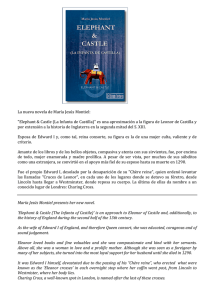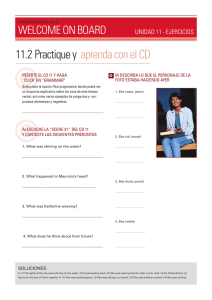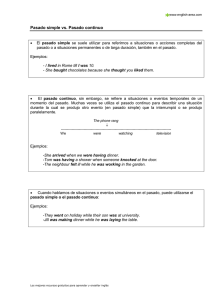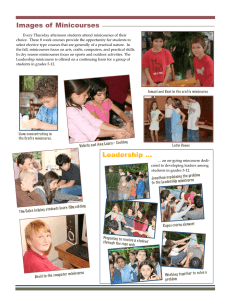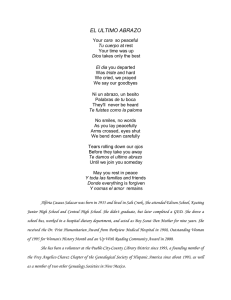Guia de orientacion modulo de ingles saber pro 2015 2
Anuncio
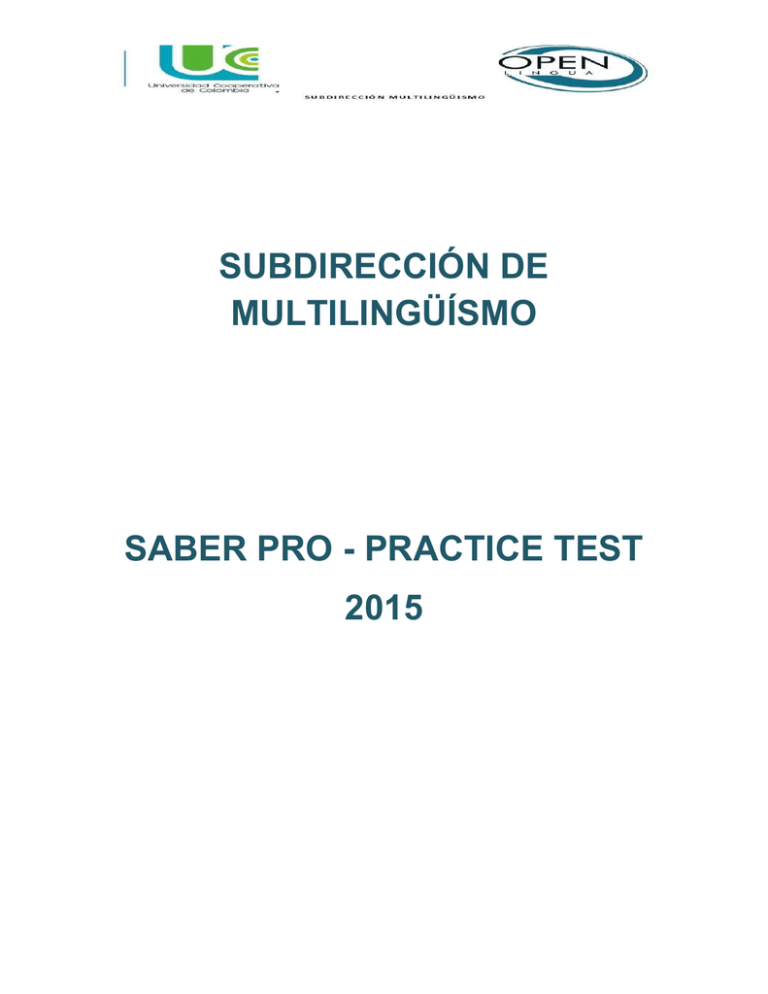
Preparación para el Cursos para el GMAT Curso de redacción para empresas SUBDIRECCIÓN DE MULTILINGÜÍSMO SABER PRO - PRACTICE TEST 2015 MÓDULO DE INGÉS Este módulo evalúa las competencias bajo los parámetros del Marco Común Europeo de Referencia para las lenguas, el cual permite clasificar a los examinados en cuatro niveles de desempeño A1, A2, B1, B2. Nivel A1 • El estudiante es capaz de comprender y utilizar expresiones cotidianas de uso muy frecuente, así como frases sencillas destinadas a satisfacer necesidades de tipo inmediato. • Puede presentarse él mismo y ante otros, pedir y dar información personal básica sobre su domicilio, sus pertenencias y las personas que conoce. • Puede relacionarse de forma elemental siempre que su interlocutor hable despacio y con claridad y esté dispuesto a cooperar. Nivel A2 • El estudiante es capaz de comprender frases y expresiones de uso frecuente relacionadas con áreas de experiencia especialmente relevantes (información básica sobre él mismo y su familia, compras, lugares de interés, ocupaciones, etc.). • Sabe comunicarse a la hora de llevar a cabo tareas simples y cotidianas que no requieran más que intercambios sencillos y directos de información sobre cuestiones conocidas o habituales. • Sabe describir en términos sencillos aspectos de su pasado y su entorno, así como cuestiones relacionadas con sus necesidades inmediatas. Nivel B1 • El estudiante es capaz de comprender los puntos principales de textos claros y en lengua estándar, si tratan cuestiones conocidas, ya sea en situaciones de trabajo, de estudio o de ocio. • Sabe desenvolverse en la mayoría de situaciones que pueden surgir durante un viaje por zonas donde se utiliza la lengua. • Es capaz de producir textos sencillos y coherentes sobre temas que le son familiares o en los que tiene un interés personal. • Puede describir experiencias, acontecimientos, deseos y aspiraciones, así como justificar brevemente sus opiniones o explicar sus planes. Nivel B2 • El estudiante es capaz de entender las ideas principales de textos complejos que traten de temas concretos abstractos, incluso si son de carácter técnico, siempre que estén dentro de su especialización. • Puede relacionarse con hablantes nativos con un grado suficiente de fluidez y naturalidad, de modo que la comunicación se realice sin esfuerzo por ninguno de los interlocutores. • Puede producir textos claros y detallados en torno a temas diversos, así como defender un punto de vista sobre temas generales indicando los pros y los contras de las distintas opciones. Características del Módulo Este módulo cuenta con 35 preguntas para ser respondidas en una (1) hora y se encuentran organizadas en 5 partes como se describe a continuación: Parte 1 El estudiante encuentra una lista de ocho palabras clasificadas de A a H. Cada una de las preguntas describe una de las ocho palabras y el estudiante debe buscar la relación entre las dos y marcar la letra correcta (A a H), en su hoja de respuestas. Hay más palabras (A a H) de las que el estudiante necesita. Parte 2 El estudiante encuentra cinco conversaciones cortas. Se debe completar la conversación seleccionando la respuesta correcta entre las tres opciones A, B ó C, en la hoja de respuestas. Parte 3 El estudiante encuentra un texto con 8 espacios, los cuales debe llenar seleccionando la palabra correcta, para cada espacio, entre las tres opciones A, B ó C, en su hoja de respuestas. Parte 4 El estudiante encuentra un texto seguido por siete preguntas, en las cuales debe seleccionar la respuesta correcta entre tres opciones A, B ó C, en su hoja de respuestas. Parte 5 El estudiante encuentra un texto con 10 espacios que debe llenar seleccionando la palabra correcta, para cada espacio, entre las cuatro opciones A, B, C ó D, en su hoja de respuestas. Estrategias para mejorar las competencias evaluadas en el Módulo Vocabulario: A. Construcción de Vocabulario http://www.vocabulary.co.il/languages/construccion-de-vocabulario/ http://www.mansioningles.com/Vocabulario.htm B. Trucos para aprender y retener vocabulario http://aprendeinglessila.com/2014/05/trucos-aprender-vocabulario-ingles/ Comprensión de lectura: A. Prediction http://funlam-english-one.blogspot.com/2008/10/lesson-one-previewing-and-predicting.html http://www.ereadingworksheets.com/free-reading-worksheets/reading-comprehensionworksheets/making-predictions-worksheets-and-lessons/ B. Skimming http://readingstrategies.wikidot.com/skimming C. Scanning http://readingstrategies.wikidot.com/scanning D. Ejercicios http://brendacuevaslabarca.blogspot.com/2011/08/unidad-3-homework-tecnicas-de-lectura.html http://www.upv.es/jugaryaprender/ingles/reading.htm Practice Test Part 1 Responda las preguntas 1 a 5 de acuerdo con el ejemplo Preguntas 1 – 5 Lea las descripciones de la columna de la izquierda (1 – 5) y las palabras de la columna de la derecha (A – H). ¿Cuál palabra (A – H) concuerda con la descripción de cada frase de la izquierda (1 – 5)? En las preguntas 1 – 5, marque la letra correcta A – H en su hoja de respuestas. Ejemplo: 0. Performs arithmetic operations on numbers. Respuesta: 0 A B C D E F G 1. Shaves away pencil´s worm surface. A. Puncher 2. Measures distances. B. Sharpener 3. Removes pencil markings. C. Eraser 4. Joins sheets of papers. D. Stapler 5. Creates holes in sheets of paper E. Ruler F. Pencil G. chalk H. Calculator H Part 2 Complete las cinco conversaciones. En las preguntas 6 – 10, marque A, B ó C en su hoja de respuestas. Ejemplo: What are they doing? A. They are wearing jackets. B. They are coworkers. C. They are discussing about a project. Respuesta: 1 6. A. B. C. A B C I love soup. I do too It can too You are too 7. I don´t have a car. A. I don´t either B. I have too C. But I am 8. Where were you last night? A. At noon B. At Christmas C. At home 9. What did you have for dinner? A. No, thanks B. It is too late C. Ham and cheese 10. What would you like? A. Yes, I would. B. Fish C. No, I don´t Part 3 Lea el artículo y seleccione la palabra adecuada para cada espacio. En las preguntas 11 – 18, marque la letra correcta A, B o C en su hoja de respuestas. Julian works 0 the bookstore. First, 11 job is to unload boxes of books from the truck. Then he opens the boxes. After that, Julian puts the books in different piles. One pile is for books that tell true 12. These are called books of fact. Another pile is for books that tell stories that are not true. These are called books of fiction. Julian then puts the books 13 shelves in the 14. Putting books on shelves is what Julian likes to do best at work. When Julian has free 15 at work, he likes to read through 16 of the books. His favorite books are the ones that tell true stories about real people and their lives. On Sunday and Monday, Julian 17 not work at the bookstore. On these days, he stays at home. He uses this time to write a story about 18. Julian grew up in Peru. Now he lives in the United States. He works at the bookstore to pay for school. Julian wants to be a teacher. One day, he hopes to turn his story into a book. He hopes to see it at the bookstore. Ejemplo: 0. A. in B. on C. at Respuesta: 11. 12. 13. 14. 15. 16. 17. 18. A. His A. histories A. in A. library A. time A. every A. does A. himself B. her B. Old sayings B. on B. bookstore B. season B. all B. is B. his 0 A B C. your C. stories C. at C. hall C. hour C. single C. do C. he C Part 4 Responda las preguntas 19 a 25 de acuerdo con el siguiente texto Lea el artículo y luego responda las preguntas En las preguntas 19 – 25, marque la letra correcta A, B o C en su hoja de respuestas. NO PLACE LIKE HOME Last October Vicky Samson ran away from home. How did it all start? “I hated school. We always had so much to do, and I didn’t see the point of it all. But it was worse at home. My parent just didn’t understand. It was always: Do this! Don’t do that! We only spoke to each other when we were fighting. One day I just couldn`t stand it anymore. That day, Vicky didn’t go to school. She put some clothes in her backpack, threw her books away, went to the bus station, and took a bus to New York City. “At first it was pretty exciting. There were bright lights, theaters, and stores, and some really interesting people. I had to sleep on the streets, but I didn’t mind. I was free-no school, no homework, and no parents.” But soon there was no food and no money either. “Someone ripped off my purse about a week after I arrived. I couldn’t get a decent job because I was only 15, and you have to be 16. I worked in a restaurant for a while, washing dishes. That was really funny because I’d always complained about doing the dishes at home. I didn’t make much money, but at least it was warm.” Then the restaurant closed down, and Vicky was back on the streets. She was cold, hungry, and miserable, but she survived until one night about a week before Christmas. “I was walking down the streets when I looked into someone’s front window. There was a girl there, just like me. She was decorating a Christmas tree. I thought, “If I were at home, I’d be decorating our tree now. Then I couldn’t help it. I just started crying. I sat down on the sidewalk and cried and cried.” Luckily for Vicky, the man who lived in the house, Mr. Escobar, came home when she was sitting there. He took Vicky inside, and Mrs. Escobar gave her something to eat. “They were so nice. I told them my whole story. They offered to pay for my ticket home, but I didn’t want that. I thought my parents would be angry.” But the next day she was back home again. While Vicky was in her living room, Mrs. Escobar went upstairs to the bedroom and called the police. Five hours later, Vicky’s father arrived to pick her up. “It was the best Christmas present I’d ever had,” said Mrs. Samson. “We’re so grateful to the Escobars for what they did.” Today Vicky Samson came from school at four o’clock. She watched TV for half an hour. Then she did her homework. She’s working hard right now because she has her final exams soon. After dinner, while she was helping with the dinner, she talked to her parents about a problem she has been having at school. Ejemplo: 0. Vicky ran away from home because: A. She was in love. B. She hated her school. C. She hated her school and home. Respuesta: 19. How did she do it? A. She drove his dad’s car to New York. B. She took a bus to New York. C. She took a taxi to New York. 20. How did she feel when she first arrived in New York City? A. She felt exhausted. B. She felt happy. C. She felt upset. 21. Why did she feel exciting? A. Because she was in a new city. B. Because she didn’t have to do chores at home. C. Because she was out of school and home. 22. How did she survive? A. She asked for money on the streets. B. She got food in a restaurant for a while. C. She got a job in a restaurant for a while. 23. She didn’t get a decent job in N.Y. because: A. She was too young. B. She was a foreigner. C. She was a shy girl. 24. Why she didn’t have money? A. Because someone stole her purse. B. Because she lost her purse. C. Because she forgot her purse at home. 25. What made her want to go home? A. She didn’t have money. B. She felt tired. C. She started to miss her family. Part 5 Responda las preguntas 26 a 35 de acuerdo con el siguiente texto. Lea el artículo y seleccione la palabra adecuada para cada espacio. En las preguntas 26 – 35, marque la letra correcta A, B, C o D en su hoja de respuestas. PARROT CATCHES BURGLAR At 10 p.m. last night, Mrs. King, 0 seventy-year-old widow, 26 to the bed as usual. She 27 that she had left the kitchen window slightly open. Or that a burglar 28 the house. At midnight, the burglar 29 through the window into the kitchen. But, suddenly, he 30 a very loud voice saying: “put your hands up or I’ll shoot”. Mrs. King 31 awake and immediately 32 the police. When the police 33 , the burglar 34 in the middle of the kitchen with both hands above his head. Mrs. King’s husband had been a police sergeant and he had thought Percy their Parrot to say “Put your hands up or I’ll shoot!” Mrs. King 35 so happy with Percy. 0. A. some B. the C. a D. an Respuesta: 0 A B C D 26. A. was going B. went C. goes D. has gone 31. A. was B. were C. is D. is being 27. A. doesn’t know B. she didn’t know C. she didn’t knew D. she hasn´t known 32. A. was phoning B. phoned C. phones D. has phoned 28. A. was watching B. were watching C. is watching D. has been watching 33. A. were arriving B. was arriving C. arrived D. was arrived 29. A. climbs B. was climbing C. climbed D. to climb 34. A. was standing B. were standing C. stood D. stands 30. A. heard B. was hearing C. hears D. is hearing 35. A. were B. was C. is D. is being Posición 1 2 3 4 5 6 7 8 9 10 11 12 13 14 15 16 17 18 19 20 21 22 23 24 25 26 27 28 29 30 31 32 33 34 35 Clave B E C D A A A C C B A C B B A B A A C B B C C A A B B A C A A B C A B
